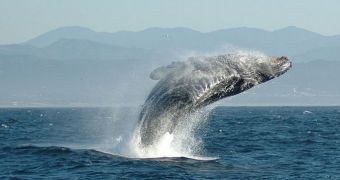Speaking on February 21 in San Diego, at the annual meeting of the American Association for the Advancement of Science (AAAS), expert Christopher Clark, who is the I.P. Johnson director of the Cornell University Laboratory of Ornithology Bioacoustics Research Program, explained some of the challenges these intelligent animals, the whales, were faced with. Using state-of-the-art acoustic animations, the scientist placed into perspective some of the challenges that whales needed to get past, if they were to survive, PhysOrg reports.
According to the expert, the land is not the only region of the world that is currently getting busier. The same exact thing is happening in the world's oceans, especially in terms of noise. Clark has developed a series of new acoustic models of the global waters today, using data collected from a large number of underwater recorders. These instruments were extremely precise in collecting a large variety of noises that permeated the oceans at their respective locations. The results of the investigation revealed that busy shipping lanes such as the eastern and western US coastlines were polluting the water with a lot of noise, which in turn interfered with the whales' ability to communicate with each other.
Other fish, and a number of simpler organisms, were also affected by this type of pollution, the expert said. Whales, for example, evolved to be able to communicate with each other over large distances, of several miles, using the calm waters as a propagating medium. “People have no idea the world in the ocean off the coast is so urbanized,” Clark said at the AAAS meeting. His investigation also focused on tracking a number of endangered whale species, such as the North Atlantic right whale. During the study, recorders were placed under circulated water corridors for up to three months, were then retrieved, and had the data they contained transferred to a visual format.
“Now I can quantify how much [sound is generated] every time a ship comes through. It creates acoustic 'bleaching,' and you can measure how much acoustic space is lost by ships coming through. For example, every day right whales lose 80 to 85 percent of their opportunities to communicate as a result of ship traffic,” the expert said. “Now we are listening to observe what the whales do as noise levels go up,” he added. Preliminary results have revealed that the animals most often prefer evacuating an area in which they cannot hear each other.

 14 DAY TRIAL //
14 DAY TRIAL //